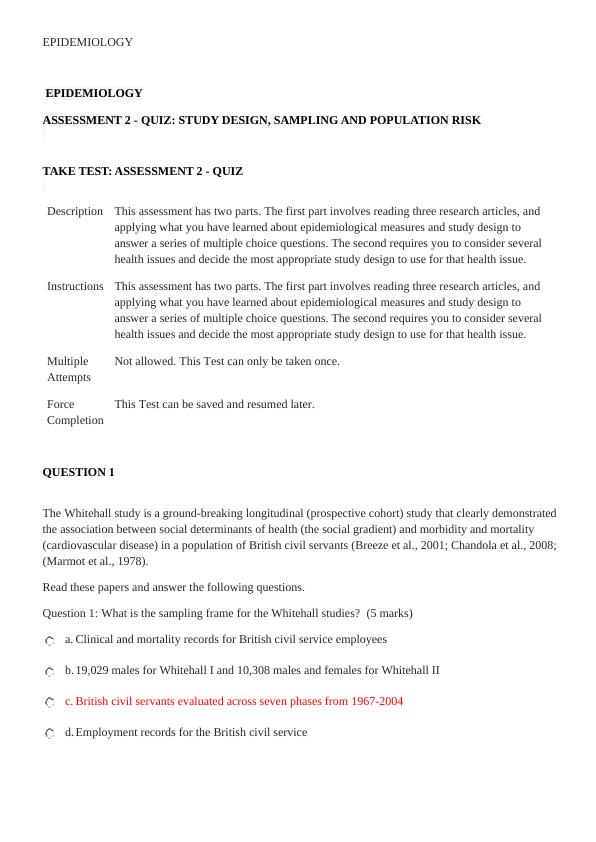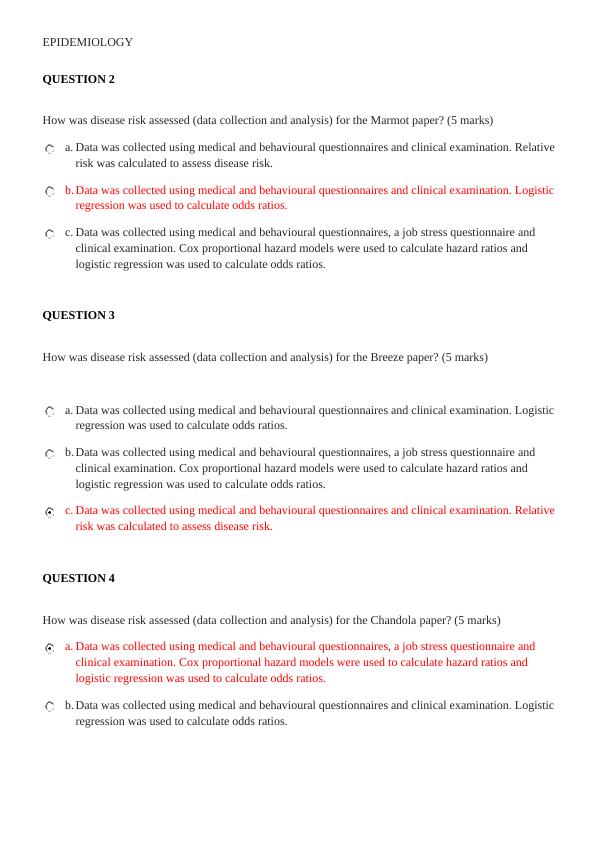Epidemiology: Study Design, Sampling and Population Risk Quiz
Added on 2023-06-03
11 Pages2646 Words274 Views
Running head: EPIDEMIOLOGY
Epidemiology
Student’s Name
Professor’s Name
Institutional Affiliation
Date
Epidemiology
Student’s Name
Professor’s Name
Institutional Affiliation
Date

EPIDEMIOLOGY
EPIDEMIOLOGY
ASSESSMENT 2 - QUIZ: STUDY DESIGN, SAMPLING AND POPULATION RISK
TAKE TEST: ASSESSMENT 2 - QUIZ
Description This assessment has two parts. The first part involves reading three research articles, and
applying what you have learned about epidemiological measures and study design to
answer a series of multiple choice questions. The second requires you to consider several
health issues and decide the most appropriate study design to use for that health issue.
Instructions This assessment has two parts. The first part involves reading three research articles, and
applying what you have learned about epidemiological measures and study design to
answer a series of multiple choice questions. The second requires you to consider several
health issues and decide the most appropriate study design to use for that health issue.
Multiple
Attempts
Not allowed. This Test can only be taken once.
Force
Completion
This Test can be saved and resumed later.
QUESTION 1
The Whitehall study is a ground-breaking longitudinal (prospective cohort) study that clearly demonstrated
the association between social determinants of health (the social gradient) and morbidity and mortality
(cardiovascular disease) in a population of British civil servants (Breeze et al., 2001; Chandola et al., 2008;
(Marmot et al., 1978).
Read these papers and answer the following questions.
Question 1: What is the sampling frame for the Whitehall studies? (5 marks)
a. Clinical and mortality records for British civil service employees
b. 19,029 males for Whitehall I and 10,308 males and females for Whitehall II
c. British civil servants evaluated across seven phases from 1967-2004
d. Employment records for the British civil service
EPIDEMIOLOGY
ASSESSMENT 2 - QUIZ: STUDY DESIGN, SAMPLING AND POPULATION RISK
TAKE TEST: ASSESSMENT 2 - QUIZ
Description This assessment has two parts. The first part involves reading three research articles, and
applying what you have learned about epidemiological measures and study design to
answer a series of multiple choice questions. The second requires you to consider several
health issues and decide the most appropriate study design to use for that health issue.
Instructions This assessment has two parts. The first part involves reading three research articles, and
applying what you have learned about epidemiological measures and study design to
answer a series of multiple choice questions. The second requires you to consider several
health issues and decide the most appropriate study design to use for that health issue.
Multiple
Attempts
Not allowed. This Test can only be taken once.
Force
Completion
This Test can be saved and resumed later.
QUESTION 1
The Whitehall study is a ground-breaking longitudinal (prospective cohort) study that clearly demonstrated
the association between social determinants of health (the social gradient) and morbidity and mortality
(cardiovascular disease) in a population of British civil servants (Breeze et al., 2001; Chandola et al., 2008;
(Marmot et al., 1978).
Read these papers and answer the following questions.
Question 1: What is the sampling frame for the Whitehall studies? (5 marks)
a. Clinical and mortality records for British civil service employees
b. 19,029 males for Whitehall I and 10,308 males and females for Whitehall II
c. British civil servants evaluated across seven phases from 1967-2004
d. Employment records for the British civil service

EPIDEMIOLOGY
QUESTION 2
How was disease risk assessed (data collection and analysis) for the Marmot paper? (5 marks)
a. Data was collected using medical and behavioural questionnaires and clinical examination. Relative
risk was calculated to assess disease risk.
b. Data was collected using medical and behavioural questionnaires and clinical examination. Logistic
regression was used to calculate odds ratios.
c. Data was collected using medical and behavioural questionnaires, a job stress questionnaire and
clinical examination. Cox proportional hazard models were used to calculate hazard ratios and
logistic regression was used to calculate odds ratios.
QUESTION 3
How was disease risk assessed (data collection and analysis) for the Breeze paper? (5 marks)
a. Data was collected using medical and behavioural questionnaires and clinical examination. Logistic
regression was used to calculate odds ratios.
b. Data was collected using medical and behavioural questionnaires, a job stress questionnaire and
clinical examination. Cox proportional hazard models were used to calculate hazard ratios and
logistic regression was used to calculate odds ratios.
c. Data was collected using medical and behavioural questionnaires and clinical examination. Relative
risk was calculated to assess disease risk.
QUESTION 4
How was disease risk assessed (data collection and analysis) for the Chandola paper? (5 marks)
a. Data was collected using medical and behavioural questionnaires, a job stress questionnaire and
clinical examination. Cox proportional hazard models were used to calculate hazard ratios and
logistic regression was used to calculate odds ratios.
b. Data was collected using medical and behavioural questionnaires and clinical examination. Logistic
regression was used to calculate odds ratios.
QUESTION 2
How was disease risk assessed (data collection and analysis) for the Marmot paper? (5 marks)
a. Data was collected using medical and behavioural questionnaires and clinical examination. Relative
risk was calculated to assess disease risk.
b. Data was collected using medical and behavioural questionnaires and clinical examination. Logistic
regression was used to calculate odds ratios.
c. Data was collected using medical and behavioural questionnaires, a job stress questionnaire and
clinical examination. Cox proportional hazard models were used to calculate hazard ratios and
logistic regression was used to calculate odds ratios.
QUESTION 3
How was disease risk assessed (data collection and analysis) for the Breeze paper? (5 marks)
a. Data was collected using medical and behavioural questionnaires and clinical examination. Logistic
regression was used to calculate odds ratios.
b. Data was collected using medical and behavioural questionnaires, a job stress questionnaire and
clinical examination. Cox proportional hazard models were used to calculate hazard ratios and
logistic regression was used to calculate odds ratios.
c. Data was collected using medical and behavioural questionnaires and clinical examination. Relative
risk was calculated to assess disease risk.
QUESTION 4
How was disease risk assessed (data collection and analysis) for the Chandola paper? (5 marks)
a. Data was collected using medical and behavioural questionnaires, a job stress questionnaire and
clinical examination. Cox proportional hazard models were used to calculate hazard ratios and
logistic regression was used to calculate odds ratios.
b. Data was collected using medical and behavioural questionnaires and clinical examination. Logistic
regression was used to calculate odds ratios.

EPIDEMIOLOGY
c. Data was collected using medical and behavioural questionnaires and clinical examination. Relative
risk was calculated to assess disease risk.
QUESTION 5
When we consider whether we can generalise the results of these studies to other populations, we need to
consider (select all that apply):
a. The type of work done by the people in the population
b. The gender distribution of the population
c. Economic similarity of the population
d. The class structure of the population
e. Ethnic diversity within the population
f. Whether the population is in a rural or remote location
QUESTION 6
Could we use an existing Australian research study cohort, such as the 45 and Up study, to explore the
same things as explored in the Whitehall studies? Why/ why not? (Short answer question) (20 marks)
Yes, we can use an existing Australian research study cohort. The main reasons why we can use an existing
Australian research study cohort to explore the same things explored in the Whitehall studies are:
We have many Australians who have varying grades of employment.
We have many Australians especially the old who experience different socioeconomic
disadvantages.
We have many Australians who work in very stressing work environments and thus end up
suffering from work stress.
QUESTION 7
c. Data was collected using medical and behavioural questionnaires and clinical examination. Relative
risk was calculated to assess disease risk.
QUESTION 5
When we consider whether we can generalise the results of these studies to other populations, we need to
consider (select all that apply):
a. The type of work done by the people in the population
b. The gender distribution of the population
c. Economic similarity of the population
d. The class structure of the population
e. Ethnic diversity within the population
f. Whether the population is in a rural or remote location
QUESTION 6
Could we use an existing Australian research study cohort, such as the 45 and Up study, to explore the
same things as explored in the Whitehall studies? Why/ why not? (Short answer question) (20 marks)
Yes, we can use an existing Australian research study cohort. The main reasons why we can use an existing
Australian research study cohort to explore the same things explored in the Whitehall studies are:
We have many Australians who have varying grades of employment.
We have many Australians especially the old who experience different socioeconomic
disadvantages.
We have many Australians who work in very stressing work environments and thus end up
suffering from work stress.
QUESTION 7

End of preview
Want to access all the pages? Upload your documents or become a member.
Related Documents
Sampling Frame and Disease Risk Assessment in Epidemiologylg...
|6
|1345
|444
Study Design, Sampling and Population Risk in Epidemiologylg...
|7
|1920
|141
Epidemiology: Risk Assessment, Generalisability, Feasibility and Limitationslg...
|6
|1362
|123
Epidemiology: Sampling Frame, Disease Risk Assessment and Generalization of Resultslg...
|6
|1300
|88
Study Design for Research: Types, Advantages and Disadvantageslg...
|9
|2387
|397
Healthcare Epidemiology Answer 2022lg...
|9
|1906
|10